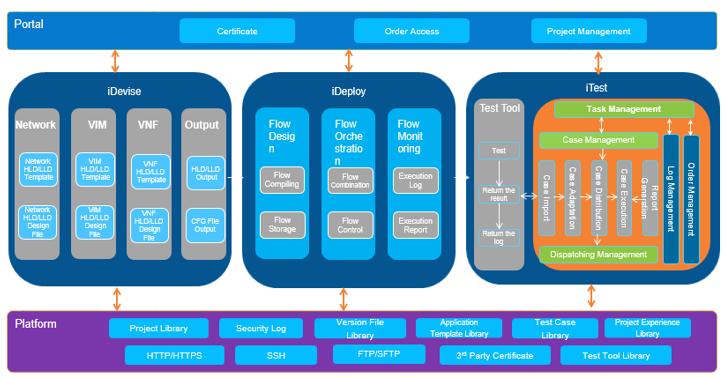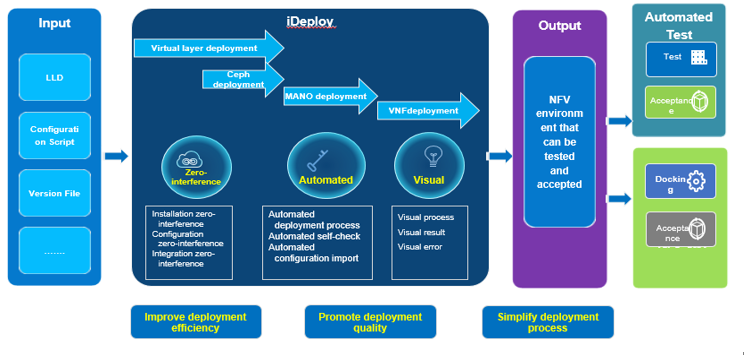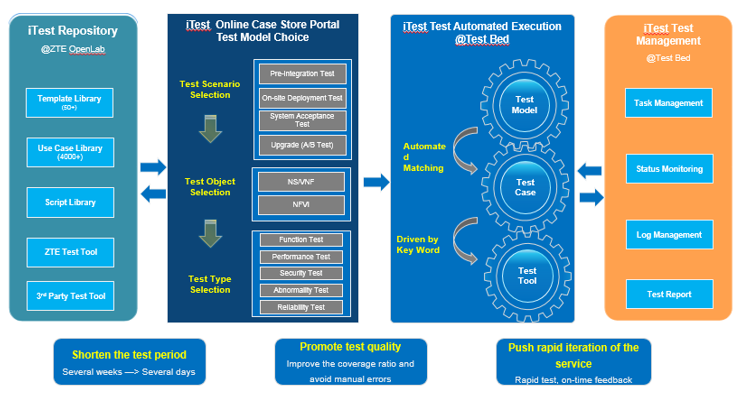The virtualized network construction needs the automatic solution
The global telecom network is gradually evolving towards virtualization. However, the decoupling degree of software from hardware increases after virtualization, and the networking becomes more complicated. The network architecture is evolving towards multiple manufacturers, multiple platforms, multiple components, and multiple interfaces. Operators are facing many challenges during virtualization network construction, such as integration of multiple vendors across the domain. End-to-end and automatic tool solutions are urgently required to reduce the integration difficulty, solidify the integration process and improve integration efficiency.
Recently, ZTE officially released the NFV AIC (Auto Integration Center) platform, which can fully meet the requirements of operators. The AIC, through integrating and solidifying the NFV integration process, implements the automation of planning and design, network deployment, and acceptance tests of core network virtualization through tools, significantly shortening the network construction time. In addition, the AIC implements the "zero distance" between functions and customer requirements in the full lifecycle of NFV integration server through a friendly user interface, effectively solving the pain points of operators in the integration of virtualized networks.
The AIC is used to achieve innovations of the virtualized network construction mode
The AIC provides end-to-end and one-stop tools for virtualized core network construction, including planning and design, solution verification, network deployment, and integration test. Through the tool, NFVI integration, MANO integration, VNF integration, and other integration scenarios can be implemented automatically. This greatly reduces the integration difficulty of network construction, improves efficiency, guarantees quality, reduces integration costs, accelerates NFV network construction, and helps customers achieve rapid network transformation.
- Automatic output of the NFV network integration design, improving the efficiency of integration design, integrating the automatic generation of LLD, shortening the integration design time and reducing the workload of traditional commissioning from several weeks to less than one day.
- Automatic implementation of the integrated deployment of NFV networks with one click, reducing the difficulty of on-site deployment and increasing the deployment efficiency dozens of times (single DC deployment within one day).
- Automatic implementation of NFV network integration tests. There are more than 5,000 test cases, which match the customer's requirements, automatically generate a test solution and execute the test and output results.
By using the AIC, operators can automatically complete the planning, deployment, and testing of virtualized networks, greatly improving the integration efficiency and quality of NFV networks. The AIC really achieves the innovation of the NFV integration mode.
Description of the AIC architecture and functions
The overall architecture of the AIC is displayed as follows:

Figure 1 AIC Platform Architecture
The AIC has three service modules and one support platform:
- Design tool (iDevise): Through the GUI interface, summarize the configuration parameters and resources that are required for deploying the hardware, cloud platform, MANO and VNF, and automatically generate the instantiation parameter files and design documents of the integration scene components.
- Deployment tool (iDeploy): Receive the instantiation parameter files generated by the design tool, make deployment of hardware, cloud platform, MANO and VNF, and implement the data configuration of the VNF office.
- Test tool (iTest): After the cloud platform, both MANO and VNF are deployed. The cloud platform and VNF with the test tool are tested to verify whether the functional components meet the design requirements.
- Unified Portal platform: Manage the process data of the integration project, accumulate the integration experience, and update the integration asset database to provide capability support for the three functional components.
iDevise simplifies the NFV network integration design
Its service flows and implementation functions are displayed as follows:

Figure 2 Service Flows of the Integration Planning Module iDevise
- Simplifying design input: Simplify the design input interface, and make it easier to input planning design parameters through the combination of automatic configurations.
- Reducing technical difficulties: The visualized planning and design process, through solidifying the design template, is used to make the design process easier so that the personnel skills are reduced.
- Shortening the design time: Automatically generate all component instantiation parameter files of the integration scenarios, optimize the configuration steps, and avoid repeated work to make the planning and design more efficient and faster.
iDeploy simplified the integration deployment of NFV networks
The service flows and implementation functions of iDeploy are displayed as follows:

Figure 3 Service Flows of the Integrated Deployed Component iDeploy
- Improving deployment efficiency: Support visual deployment preview and basic deployment input with zero intervention in the deployment process, and output the virtualization environment that can be tested and accepted.
- Improving the deployment quality: The automatic end-to-end NE deployment allows users to observe the entire deployment process in real time, and supports real-time query of deployment progress, exceptions, log information and reports to guarantee the entire deployment process.
- Simplifying the deployment process: The deployment process is automatic. From VIM deployment to MANO deployment, VNF deployment, and basic configuration of VNF and TOR/EOR, the automatic deployment tool can be used to automatically complete the process.
iTest simplifies the integration test of NFV networks
The service flows and implementation functions of iTest are described as follows:

Figure 4 Service Flows of the Integration Test Component iTest
- Shortening the test period: Implement automatic test of the functions, reliability and performance of the hardware/cloud platform/MANO/VNF, and make interconnection of NEs and components independently, thus saving test personnel and shortening the test period.
- Improving the test quality: Determine the test scheme, generate and execute cases, and output reports automatically to avoid manual errors and improve the test quality.
- Make quick iteration of services: Test cases can be edited according to the actual configuration. The test cases are rich in scenarios, so they can better adapt to customer requirements. The test can be completed quickly, and customer services can be rapidly iterated.
NFV project assets management implements unified management of unified assets
The AIC tool platform supports unified access and management of NFV projects. The platform integrates project asset management, makes experience accumulation, and implements information management and release through the project library, template library, case library, version library, and experience library functions. The AIC tool platform solves the problem that traditional projects cannot effectively integrate design documents or test cases, and cannot be duplicated.
Applications of the virtualized AIC in the NFV network construction
At present, the AIC has been successfully applied in many NFV commercial networks and pilot offices, and has been highly praised by customers.
Tianjin Unicom used the AIC to implement the integration and rapid deployment of the 5GC pilot office, and won the 2018 Best Practice Award in the SDN&NFV field of the media ICT industry. In addition, the AIC tool also participates in China Mobile's OPEN-AUTO cooperation plan. It is collaborating with operators in R&D and verification of integrated automation tools to build a partner-like industrial ecosystem, create a new mode
ZTE supports AI with full-stack IT offering
5GC Green Engine Solution to Enable Green Internet of Everything in the Dual-Carbon Era
5GC Private Network 2.0 Empowerment and Efficiency Improvement Boosts High-Quality Development of the Industry
5G Empowers Intelligent Mining for High-quality Development of Shaanxi Coal Caojiatan Mining
ZTE and China Mobile embrace digitalization for biodiversity conservation in Panda Reserve
Three Aspects Contribute to ZTE’s Remarkable Breakthroughs in Advanced G4X Server
How 5G Private Networks Are Poised to Transform Enterprises Worldwide: All Scenario Private 5G Helps Operators to Realize Private 5G as a Service
ZTE’s commitment to servers generates robust growth of up to 60 times in past 8 years
ZTE eyes top 5 global server market share
Full-Scenario One-Stop 5G Private Network for Vertical Industries

